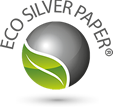THE PAPER WE THROW AWAY DAILY, WHERE DOES IT END UP?
2024-05-10 Eco Silver PaperEco Silver Paper
Have you ever asked yourself where all the paper we throw away ends up and why it is so important to separate it from the rest of the waste for recycling? There are different types of paper, from simple paper used for newspapers or books, to paper used to contain and store food. In Italy, paper and carton represent about 30% of the total waste and are a fundamental resource as they can be used to produce recycled paper. Also in Italy, around 9 million tonnes of cellulose products are consumed.
The average annual consumption is 57kg/person, and the waste produced is broken down as follows:
- 64% is recycled
- 14% is burned to produce energy
- 22% is used for other purposes (in fireplaces) or ends up in landfills
From an economic perspective, recycling is certainly less costly than incineration. It is obvious that recycled paper does not produce an equal weight of ‘new’ paper and that the process has its own economic, energy and pollution costs. Recycling reduces the amount of waste to be processed, the associated storage costs, the waste of space for storage, pollution from incineration, and of course the consumption of live trees.
To recycle about one tonne of paper requires 2700 kWh of electricity and 1800 litres of water, which is still less than it would require to make it from scratch.

Paper, if not inked, can also be subjected to aerobic degradation (composting) together with other materials of plant and/or animal origin to produce a soil conditioner useful for agriculture or the recovery of soils with low natural nutrients.
Another prospect, particularly interesting when fibres with suitable physical-mechanical characteristics cannot be obtained for new paper products, is that of chemical degradation to produce substances for industrial use (e.g. methanol).
The tissue paper sector, in particular, is sustainable by nature. Its raw material is a renewable resource with a growth cycle of about 50 years; thus, sustainability has been a way of life in the industry for centuries. Through sustainable forestry practices, the tissue industry grows and regenerates its raw material to ensure a constant supply for future generations. This preserves not only our planet, but also the future of the industry. The tissue industry is working hard to promote sustainability and circularity across the entire supply chain, from the water and energy used in production processes to the transportation of tissue products and their recovery and recycling at the end of their life cycle. Mainly bark, twigs and waste from the timber industry are used for production, and many tissue paper manufacturers are using innovation to create closed-loop products and processes that will increase product recovery and minimise waste.

The focus is also on reducing GHG emissions and switching to renewable energy. Around 58% of the European pulp and paper industry’s energy consumption already comes from renewable biomass and the sector is proud to be Europe’s largest user and producer of bioenergy.
The paper industry is also striving to reduce water consumption and is an active partner in the development of water management. In the last decade, paper machines have reduced water consumption by 30 per cent and, since 1970, the amount of water required to produce one tonne of pulp has decreased fivefold. Through innovation to reduce, reuse and remanufacture along the entire value chain, the tissue paper industry is working to meet the three pillars of sustainability (environmental, economic and social) and continue to make products that are essential to protect the health of the Earth’s inhabitants and, at the same time, the planet itself.
At Eco Silver Paper®, in addition to using raw materials of controlled origin, we design our products in such a way as to offer forms that allow them to be used responsibly, as well as actively collaborating with TREE-NATION for the reforestation of the planet through specific projects.
Fonte:
- https://www.linchiestaonline.it/4529/dove-finisce-la-carta-che-buttiamo/
- https://europeantissue.com/it/blog/carta-tissue-un-settore-sostenibile-da-secoli/
- http://gestione-rifiuti.it/smaltimento-carta-cartone
U.G.




LATEST COMMENTS